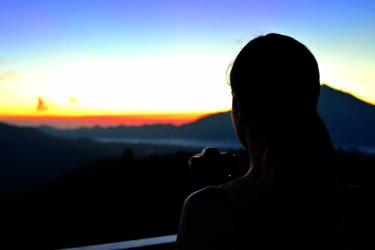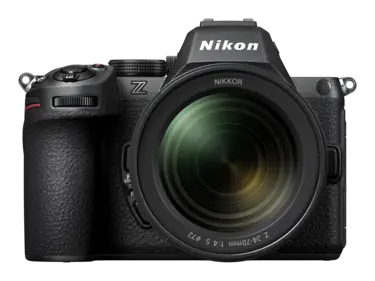How to film timelapse videos with the Z5II

Discover how to capture epic timelapses, condensing two hours of fleeting light and shifting landscapes into 60-second films that feel straight out of the cinema
When it comes to dreamy, cinematic travel content, Nikon Creators Céline Turina and Felix Wuerstle, the duo behind Memories from Abroad, have a gift for turning everyday journeys into big-screen adventures. From far-flung escapes to hidden European gems, their feed brims with polished, story-driven content. What began as a shared hobby in 2019 is now a thriving brand, inspiring thousands online. Here, the couple share their secrets for creating cinematic timelapses videos with the Nikon Z5II. “To be honest, we hadn’t really used or thought about timelapse videos before this project,” begins Céline. “But after trying it with the Z5II, we were genuinely impressed.” Felix agrees: “Watching it back for the first time left us speechless! It’s such a cool feature because you can show things that happen over a few hours in a one-minute video.”

Memories from Abroad begun by researching the best sunrise spots in Bali
Picking the perfect subject and location
Felix: Timelapse videos turn static pictures into colourful, moving scenery, and for creators it’s a good way to open or close a travel video, or even use it as a transition. But to make the video look cinematic you need a background that looks special.
Céline: We researched the best sunrise spots in Bali, and Mount Batur in Kintamani immediately stood out. For the sunset and blue hour timelapse we experimented at different rice terraces over several days, but couldn’t find anything that really worked as most places weren’t high enough to give us the sweeping views we were looking for. Then in Munduk, in the north of Bali, everything came together. At 1,200m on a mountain ridge, we had the whole valley spread out in front of us, with views stretching all the way to the ocean and even Java. It felt like the ideal place to capture that transition.
Felix: The key is to look for subjects that give you movement, such as clouds, tides, traffic, that sort of thing, as these moving elements make the timelapse feel alive and add cinematic flow rather than a static frameset. You’ll also need a landscape that offers strong shapes, such as volcano ridgelines or a city skyline, plus foreground features of the landscape or an architectural element to create depth – and capture it all as the light changes. This is why the volcano was perfect. It is completely black at first and then it lights up. Then you have the shifting from darkness to purple, pink, and then the yellows and oranges arrive, until the sun finally appears. And when it sets, the process happens in reverse. It’s just incredible to watch, because you see every shade unfold. A short timelapse video captures all of this, even though in reality it takes around two hours. Just remember that it’s crucial to know which direction you need to face. So before settling on a spot check the orientation (west/east, etc), local weather and cloud cover – and go early to secure a clean composition.
Celine and Felix set up a timelapse video in Bali
Setting up the Nikon Z5II
Felix: We used the NIKKOR Z 24-200mm f/4-6.3 VR with the Z5II, using a 24mm focal length for the videos in order to capture the entire landscape and get the most out of the colour changes. The electronic shutter keeps everything silent and vibration-free.
Céline: A tripod is absolutely essential for timelapse as you’re working over the course of two hours and even the smallest movement can ruin the sequence. With a tripod, you get maximum stability and consistency across all those frames.
Using Time-lapse Movie feature
Felix: The in-camera Time-lapse Movie feature is really straightforward, and the fact that it compiles directly into a 4K video file is great. Just go to the Photo Shooting Menu and turn on Time-lapse Movie. We found using an interval of three seconds creates the smoothest motion and keeps file sizes manageable.
Céline: Our advice is definitely to capture for longer than what you need, so for shooting time we chose two hours to give us flexibility when we later trimmed the video to the best 45 to 60 seconds. And it's good to start in the dark and finish with light, or vice versa.
Felix: By activating exposure smoothing we were able to reduce small brightness jumps, which is really helpful when working in Aperture Priority mode. To give us the maximum field of view and quality we chose FX for image area. For frame size/rate, we used 4K 25p as this gave us the best cinematic cadence, and we selected MOV for video file type for higher quality and better control over colour grading later. On the subject of colour grading, I would suggest not doing too much because the colours are quite strong already. If you have the right settings, the red, the orange, the dark blues are already very strong, and by doing too much colour grading you’ll make the video look unrealistic.
Waiting for sunrise
Specific settings
Céline: We dialled in an aperture of f/8 to ensure the whole scene stays sharp, and ISO 200 fixed to avoid flicker that would have naturally happened if it had been in Auto. As we used Aperture Priority, the shutter speed was set to automatic, which would compensate for the changes in light fall, which the Z5II handled brilliantly.
Felix: The White Balance can be set to direct sunlight or clouds, depending on the weather conditions, and for focus we went with AF-S to keep the focus on the horizon, and then switched to manual to lock, as this prevents it from hunting.
Final thoughts
Céline: The Time-lapse movie feature on the Z5II is so easy to use that everyone should give it a try. It captured the scene even more beautifully than we experienced it in person. Our next trip is to Mount Fuji in Japan and we can’t wait to see what we’ll create there!
The Nikon Z5II – tried and tested
Discover the Nikon Z5II

Unlock greater creativity







